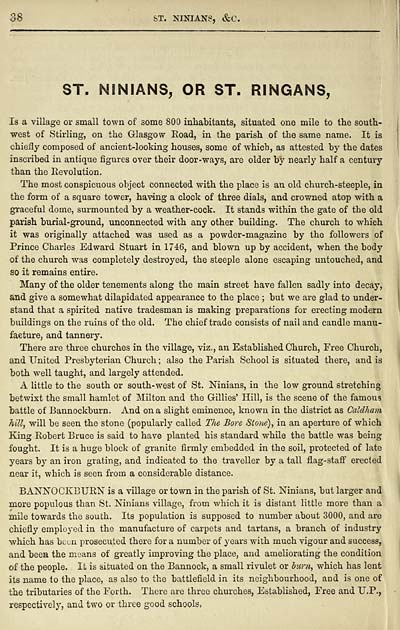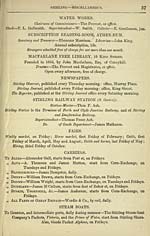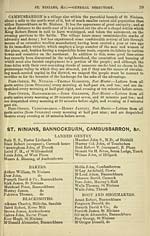Download files
Complete book:
Individual page:
Thumbnail gallery: Grid view | List view

ST. NINIAN8, &C.
ST. NINIANS, OR ST. RINGANS,
Is a village or small town of some 800 inliabitants, situated one mile to the south-
west of Stirling, on the Glasgow Eoad, in the parish of the same name. It is
chiefly composed of ancient-looking houses, some of which, as attested by the dates
inscribed in antique figures over their door-ways, are older by nearly half a century
than the Revolution.
The most conspicuous object connected with the place is an old church-steeple, in
the form of a square tower, having a clock of three dials, and crowned atop with a
graceful dome, surmounted by a weather-cock. It stands within the gate of the old
parish burial-ground, unconnected with any other building. The church to which
it was originally attached was used as a powder-magazine by the followers of
Prince Charles Edward Stuart in 1746, and blown up by accident, when the body
of the church was completely destroyed, the steeple alone escaping untouched, and
so it remains entire.
Many of the older tenements along the main street have fallen sadly into decay,
and give a somewhat dilapidated appearance to the place ; but we are glad to under-
stand that a spirited native tradesman is making preparations for erecting modern
buildings on the ruins of the old. The chief trade consists of nail and candle manu-
facture, and tannery.
There are three churches in the village, viz., an Established Church, Free Church,
and United Presbyterian Church ; also the Parish School is situated there, and is
both well taught, and largely attended.
A little to the south or south-west of St. Ninians, in the low ground stretching
betwixt the small hamlet of Milton and the Gillies' Hill, is the scene of the famous
battle of Bannockburn. And on a slight eminence, known in the district as Caldham
hill, will be seen the stone (popularly called The Bore Stone), in an aperture of which
King Robert Bruce is said to have planted his standard while the battle was being
fought. It is a huge block of granite firmly embedded in the soil, protected of late
years by an iron grating, and indicated to the traveller by a tall flag-stafi" erected
near it, which is seen from a considerable distance.
BANNOCKBURN is a village or town in the parish of St. Ninians, but larger and
more populous than St. Ninians village, from which it is distant little more than a
mile towards the south. Its population is supposed to number about 3000, and are
chiefly employed in the manufacture of carpets and tartans, a branch of industry
which has been prosecuted there for a number of years with much vigour and success,
and been the means of greatly improving the place, and ameliorating the condition
of the people. It is situated on the Bannock, a small rivulet or burn, which has lent
its name to the place, as also to the battlefield in its neighbourhood, and is one of
the tributaries of the Forth. There are three churches, Established, Free and U.P.,
respectivelj^, and two or three good schools.
ST. NINIANS, OR ST. RINGANS,
Is a village or small town of some 800 inliabitants, situated one mile to the south-
west of Stirling, on the Glasgow Eoad, in the parish of the same name. It is
chiefly composed of ancient-looking houses, some of which, as attested by the dates
inscribed in antique figures over their door-ways, are older by nearly half a century
than the Revolution.
The most conspicuous object connected with the place is an old church-steeple, in
the form of a square tower, having a clock of three dials, and crowned atop with a
graceful dome, surmounted by a weather-cock. It stands within the gate of the old
parish burial-ground, unconnected with any other building. The church to which
it was originally attached was used as a powder-magazine by the followers of
Prince Charles Edward Stuart in 1746, and blown up by accident, when the body
of the church was completely destroyed, the steeple alone escaping untouched, and
so it remains entire.
Many of the older tenements along the main street have fallen sadly into decay,
and give a somewhat dilapidated appearance to the place ; but we are glad to under-
stand that a spirited native tradesman is making preparations for erecting modern
buildings on the ruins of the old. The chief trade consists of nail and candle manu-
facture, and tannery.
There are three churches in the village, viz., an Established Church, Free Church,
and United Presbyterian Church ; also the Parish School is situated there, and is
both well taught, and largely attended.
A little to the south or south-west of St. Ninians, in the low ground stretching
betwixt the small hamlet of Milton and the Gillies' Hill, is the scene of the famous
battle of Bannockburn. And on a slight eminence, known in the district as Caldham
hill, will be seen the stone (popularly called The Bore Stone), in an aperture of which
King Robert Bruce is said to have planted his standard while the battle was being
fought. It is a huge block of granite firmly embedded in the soil, protected of late
years by an iron grating, and indicated to the traveller by a tall flag-stafi" erected
near it, which is seen from a considerable distance.
BANNOCKBURN is a village or town in the parish of St. Ninians, but larger and
more populous than St. Ninians village, from which it is distant little more than a
mile towards the south. Its population is supposed to number about 3000, and are
chiefly employed in the manufacture of carpets and tartans, a branch of industry
which has been prosecuted there for a number of years with much vigour and success,
and been the means of greatly improving the place, and ameliorating the condition
of the people. It is situated on the Bannock, a small rivulet or burn, which has lent
its name to the place, as also to the battlefield in its neighbourhood, and is one of
the tributaries of the Forth. There are three churches, Established, Free and U.P.,
respectivelj^, and two or three good schools.
Set display mode to: Large image | Transcription
Images and transcriptions on this page, including medium image downloads, may be used under the Creative Commons Attribution 4.0 International Licence unless otherwise stated. ![]()
| Scottish Post Office Directories > Towns > Stirling > Threepenny guide & directory for Stirling, Bridge of Allan, etc. > (46) |
|---|
| Permanent URL | https://digital.nls.uk/85270762 |
|---|
| Description | Directories of individual Scottish towns and their suburbs. |
|---|
| Description | Around 700 Scottish directories published annually by the Post Office or private publishers between 1773 and 1911. Most of Scotland covered, with a focus on Edinburgh, Glasgow, Dundee and Aberdeen. Most volumes include a general directory (A-Z by surname), street directory (A-Z by street) and trade directory (A-Z by trade). |
|---|


